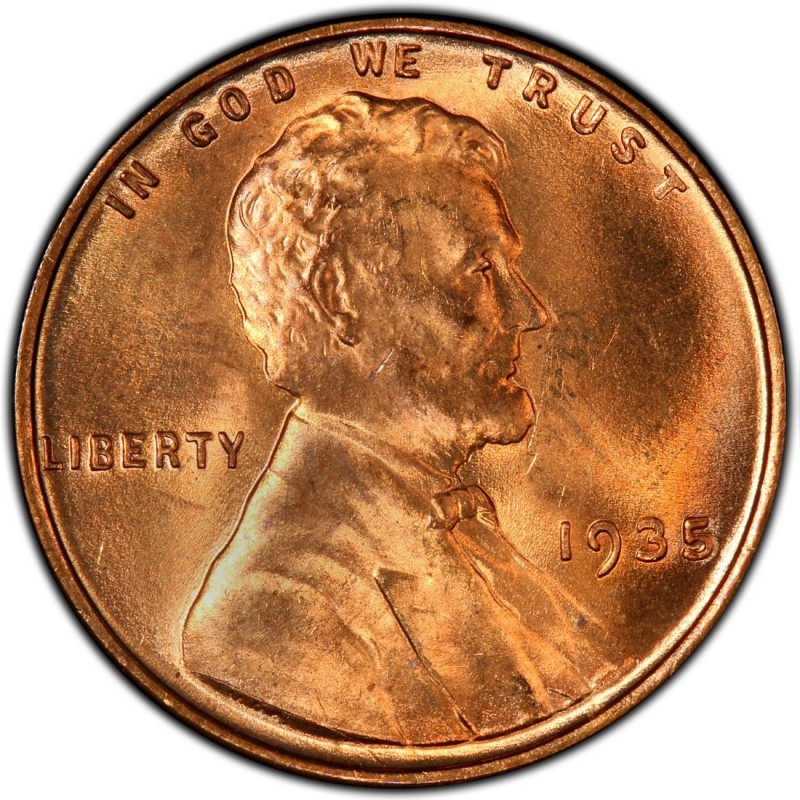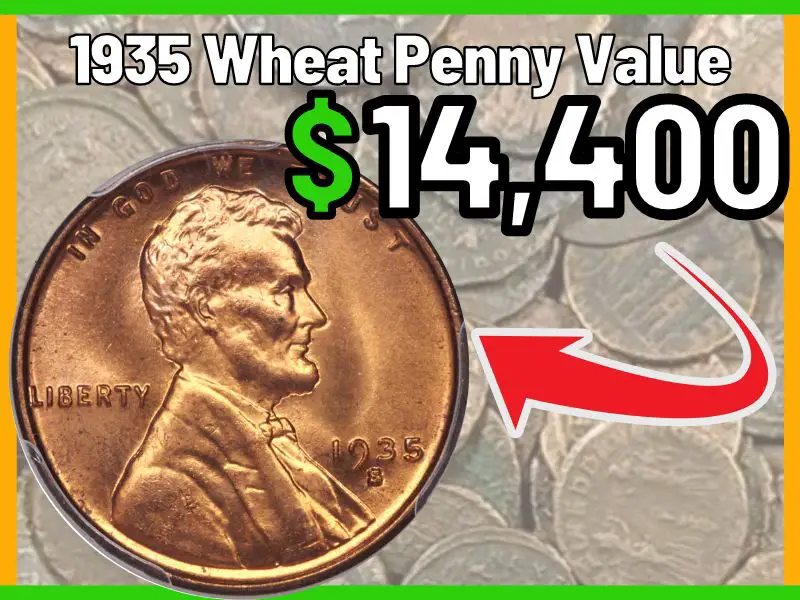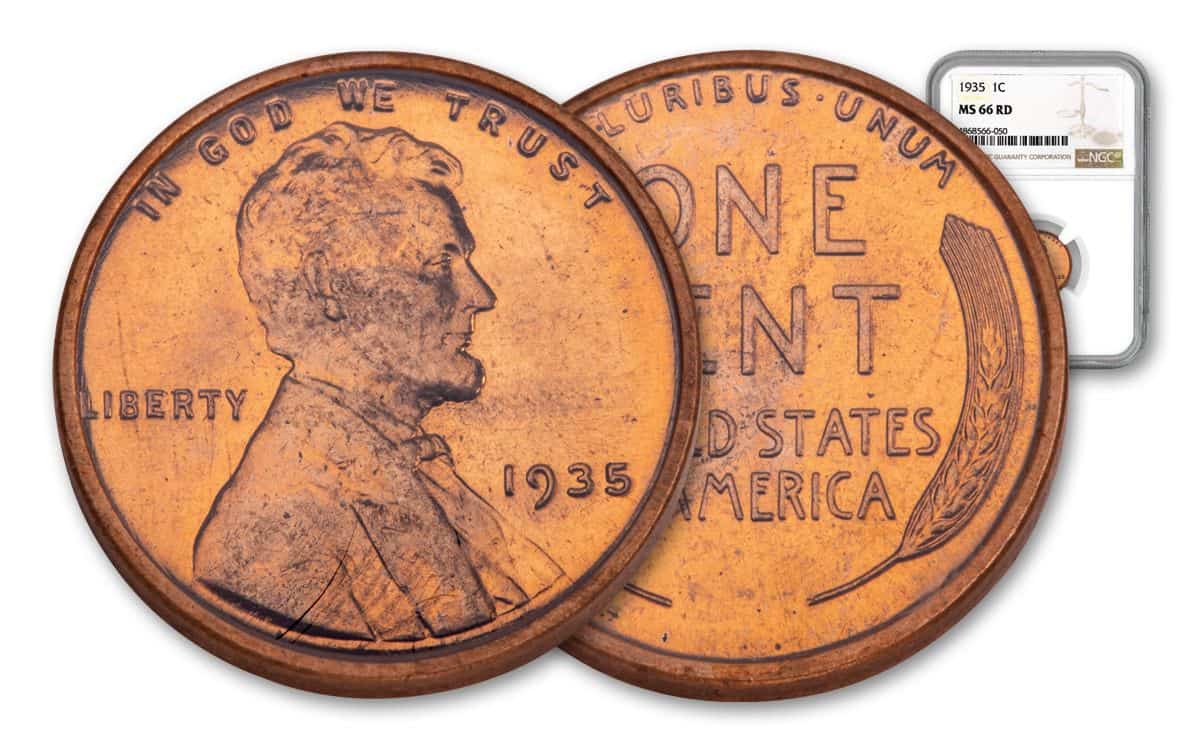The 1935 wheat penny is a valuable coin, especially in excellent condition. It is the last year that the wheat penny was minted, and it is a popular collector's item.
The wheat penny was first minted in 1909, and it was designed by Victor David Brenner. The coin features a wheat stalk on the reverse, and it is made of 95% copper and 5% zinc. The 1935 wheat penny is the last year that the coin was minted with this design. The following year, the wheat penny was redesigned with a Lincoln memorial on the reverse.
The value of a 1935 wheat penny depends on its condition. A coin in excellent condition can be worth several hundred dollars. However, a coin in poor condition may only be worth a few cents. The following are some of the factors that affect the value of a 1935 wheat penny:
- Condition: The condition of the coin is the most important factor that affects its value. A coin in excellent condition will be worth more than a coin in poor condition.
- Grade: The grade of the coin is a measure of its condition. A coin that has been graded by a professional coin grading service will be worth more than a coin that has not been graded.
- Rarity: The rarity of the coin is also a factor that affects its value. A rare coin will be worth more than a common coin.
If you have a 1935 wheat penny, you can determine its value by taking it to a coin dealer or by using an online coin grading service. You can also research the value of the coin online.
The 1935 wheat penny is a valuable coin, and it is a popular collector's item. If you have one of these coins, it is important to take care of it and store it properly.
What is the Value of a 1935 Wheat Penny
The value of a 1935 wheat penny is determined by several key aspects, including:
- Condition
- Grade
- Rarity
- Year
- Mint mark
- Errors
- Variety
The condition of the coin is the most important factor that affects its value. A coin in excellent condition will be worth more than a coin in poor condition. The grade of the coin is a measure of its condition, and a coin that has been graded by a professional coin grading service will be worth more than a coin that has not been graded. The rarity of the coin is also a factor that affects its value. A rare coin will be worth more than a common coin. The year of the coin, the mint mark, and any errors or varieties can also affect its value.
For example, a 1935 wheat penny in mint condition can be worth several hundred dollars. However, a coin in poor condition may only be worth a few cents. A rare 1935 wheat penny with an error, such as a doubled die error, can be worth thousands of dollars.
If you have a 1935 wheat penny, you can determine its value by taking it to a coin dealer or by using an online coin grading service. You can also research the value of the coin online.
1. Condition
The condition of a 1935 wheat penny is one of the most important factors that affects its value. A coin in excellent condition will be worth more than a coin in poor condition. This is because the condition of the coin affects its appearance and desirability to collectors.
There are several factors that can affect the condition of a coin, including:
- Wear and tear: Coins that have been circulated for a long period of time will show signs of wear and tear, such as scratches, dings, and nicks. These imperfections can reduce the value of the coin.
- Environmental damage: Coins that have been exposed to harsh environmental conditions, such as moisture or heat, can also be damaged. This damage can include corrosion, tarnishing, and pitting. Environmental damage can also reduce the value of the coin.
- Cleaning: Coins that have been cleaned improperly can also be damaged. Improper cleaning can remove the original patina from the coin, which can reduce its value.
2. Grade
The grade of a 1935 wheat penny is a measure of its condition. A coin's grade is determined by a professional coin grading service, such as the Numismatic Guaranty Corporation (NGC) or the Professional Coin Grading Service (PCGS). The grade of a coin is based on its appearance, including factors such as wear, scratches, and damage.
The grade of a 1935 wheat penny is an important factor that affects its value. A coin in higher grade will be worth more than a coin in lower grade. This is because a higher grade coin is more desirable to collectors. The following are some of the factors that affect the grade of a 1935 wheat penny:
- Wear: Coins that have been circulated for a long period of time will show signs of wear, such as scratches, dings, and nicks. These imperfections can reduce the grade of the coin.
- Scratches: Scratches on a coin can also reduce its grade. Scratches can be caused by improper handling or storage of the coin.
- Damage: Coins that have been damaged, such as by bending or folding, will also receive a lower grade.
The grade of a 1935 wheat penny is an important factor to consider when determining its value. A coin in higher grade will be worth more than a coin in lower grade. If you have a 1935 wheat penny, you can have it graded by a professional coin grading service to determine its grade and value.
3. Rarity
Rarity is an important factor that affects the value of a 1935 wheat penny. A rare coin will be worth more than a common coin. This is because rare coins are more difficult to find, and therefore more desirable to collectors.
There are several factors that can affect the rarity of a coin, including:
- Mintage: The mintage of a coin is the number of coins that were minted in a particular year. A coin with a low mintage will be rarer than a coin with a high mintage.
- Errors: Coins with errors are also rarer than coins without errors. Errors can occur during the minting process, and they can range from minor imperfections to major flaws.
- Variety: Coins with different varieties are also rarer than coins with common varieties. Varieties can occur due to changes in the design of the coin, or due to different dies being used to mint the coin.
The rarity of a 1935 wheat penny can be determined by researching the coin and its mintage. You can also consult with a coin dealer or a professional coin grading service to determine the rarity of your coin.
Understanding the rarity of a 1935 wheat penny is important because it can help you to determine its value. Rare coins are worth more than common coins, and they can be a valuable addition to any coin collection.
4. Year
The year in which a 1935 wheat penny was minted is an important factor that affects its value. This is because the mintage of a coin can vary from year to year, and a coin with a lower mintage will be rarer and more valuable than a coin with a higher mintage.
For example, the 1935 wheat penny has a mintage of 88,264,000 coins. This is a relatively low mintage compared to other years of the wheat penny, which means that the 1935 wheat penny is more rare and valuable than wheat pennies from other years.
In addition, the year of a coin can also affect its value if there were any significant changes to the design of the coin in that year. For example, the 1935 wheat penny was the last year that the wheat penny was minted with a wheat stalk on the reverse. The following year, the wheat penny was redesigned with a Lincoln memorial on the reverse. This change in design makes the 1935 wheat penny more unique and valuable than wheat pennies from other years.
Understanding the connection between the year and the value of a 1935 wheat penny is important for collectors and investors. By understanding this relationship, collectors and investors can make more informed decisions about which coins to buy and sell.
5. Mint mark
A mint mark is a small letter or symbol that is stamped on a coin to indicate the mint at which it was produced. Mint marks can be used to identify the year in which a coin was minted, as well as the location of the mint.
- Location of the mint: The mint mark on a 1935 wheat penny can indicate the location of the mint at which it was produced. There are three different mint marks that can be found on a 1935 wheat penny:
- Year of mintage: The mint mark on a 1935 wheat penny can also indicate the year in which it was minted. The mint mark for the 1935 wheat penny is "D", which indicates that the coin was minted at the Denver Mint.
- Rarity: The mint mark on a 1935 wheat penny can also affect its rarity. For example, the 1935-S wheat penny, which was minted at the San Francisco Mint, is rarer than the 1935-D wheat penny, which was minted at the Denver Mint.
- Value: The mint mark on a 1935 wheat penny can affect its value. For example, the 1935-S wheat penny is worth more than the 1935-D wheat penny because it is rarer.
Understanding the connection between the mint mark and the value of a 1935 wheat penny is important for collectors and investors. By understanding this relationship, collectors and investors can make more informed decisions about which coins to buy and sell.
6. Errors
Errors are a significant factor that affects the value of a 1935 wheat penny. An error is any deviation from the normal design or production of a coin. Errors can occur for a variety of reasons, including mistakes made by mint workers, die malfunctions, and even environmental factors.
- Die errors: Die errors are the most common type of error found on wheat pennies. Die errors occur when there is a problem with the die that is used to strike the coin. These errors can range from minor imperfections to major flaws.
- Strike errors: Strike errors occur when there is a problem with the striking process. These errors can include off-center strikes, double strikes, and weak strikes.
- Planchet errors: Planchet errors occur when there is a problem with the planchet, which is the blank metal disk that is used to make the coin. These errors can include clipped planchets, broadstrikes, and lamination errors.
- Environmental errors: Environmental errors occur when the coin is damaged after it has been minted. These errors can include corrosion, tarnishing, and pitting.
The value of an error coin depends on a number of factors, including the type of error, the severity of the error, and the rarity of the error. Some errors are more common than others, and some errors are more desirable to collectors. For example, a 1935 wheat penny with a doubled die error is worth more than a 1935 wheat penny with a minor die error.
If you have a 1935 wheat penny with an error, it is important to have it by a professional coin grading service. A professional coin grading service will be able to identify the error and determine its value.
7. Variety
Variety is an important factor that affects the value of a 1935 wheat penny. Variety refers to the different types of 1935 wheat pennies that were produced. These different types can be caused by a number of factors, including different dies, different mint marks, and different planchets.
One of the most common varieties of the 1935 wheat penny is the "S" variety. This variety was minted at the San Francisco Mint and is distinguished by the "S" mint mark on the reverse of the coin. The "S" variety is rarer than the more common "D" variety, which was minted at the Denver Mint, and is therefore worth more.
Another variety of the 1935 wheat penny is the "Wide AM" variety. This variety is characterized by the wide spacing between the letters "A" and "M" in the word "AMERICA" on the reverse of the coin. The "Wide AM" variety is rarer than the more common "Narrow AM" variety and is therefore worth more.
Understanding the different varieties of the 1935 wheat penny is important for collectors and investors. By understanding the different varieties, collectors and investors can make more informed decisions about which coins to buy and sell.
FAQs about the Value of a 1935 Wheat Penny
Many questions surround the value and significance of a 1935 wheat penny. This section addresses some of the most frequently asked questions to provide a comprehensive understanding.
Question 1: What factors determine the value of a 1935 wheat penny?
The value of a 1935 wheat penny is influenced by several factors, including its condition, grade, rarity, mint mark, errors, and variety.
Question 2: How can I determine the condition of my 1935 wheat penny?
Examine the coin closely for any signs of wear, scratches, or damage. Alternatively, submit it to a professional coin grading service for an expert assessment.
Question 3: What is the significance of the mint mark on a 1935 wheat penny?
The mint mark indicates the location where the coin was minted. Different mint marks can affect the rarity and value of the coin.
Question 4: Are errors on a 1935 wheat penny valuable?
Errors, such as die errors, strike errors, and planchet errors, can increase the value of a 1935 wheat penny, depending on the type and severity of the error.
Question 5: How can I determine the variety of my 1935 wheat penny?
Examine the coin carefully for any variations in the design, such as the spacing between letters or the presence of additional details. Reference numismatic resources to identify the specific variety.
Understanding these factors empowers collectors and investors to make informed decisions about the value and significance of their 1935 wheat pennies.
For further exploration, consult reputable coin dealers, numismatic societies, or online resources dedicated to wheat pennies.
Conclusion
In conclusion, the value of a 1935 wheat penny lies not only in its monetary worth but also in its historical significance and appeal to collectors.
The factors that determine the value of a 1935 wheat penny, such as its condition, grade, rarity, mint mark, errors, and variety, provide a framework for understanding its unique characteristics and desirability. By comprehending these factors, collectors and investors can make informed decisions about the value and significance of their coins.
The 1935 wheat penny stands as a testament to the rich history of American coinage and continues to captivate numismatists and enthusiasts alike. Its enduring legacy ensures that it will remain a valuable and sought-after collectible for generations to come.



Detail Author:
- Name : Miss Albertha Koch
- Username : hpurdy
- Email : winfield.volkman@gmail.com
- Birthdate : 1979-08-30
- Address : 4298 Irwin Street Apt. 554 Aldenburgh, CT 23153
- Phone : +1.859.770.2826
- Company : Bernhard, Mueller and Lowe
- Job : Technical Director
- Bio : Ut nisi facere reiciendis quo. Pariatur facilis modi dolores quasi quo dolores est qui. Cupiditate at repellat vel aut quia id.
Socials
instagram:
- url : https://instagram.com/lavonne1272
- username : lavonne1272
- bio : Voluptatem odit accusamus consequatur nobis. Quibusdam nisi dolore doloremque.
- followers : 4229
- following : 1605
twitter:
- url : https://twitter.com/robel1979
- username : robel1979
- bio : Voluptas sint quis voluptatem autem. Eos cupiditate debitis iure maxime officia reprehenderit magni dolorum. Non earum et aut nihil unde tenetur voluptates.
- followers : 1459
- following : 2929
facebook:
- url : https://facebook.com/lavonne_xx
- username : lavonne_xx
- bio : Commodi nisi voluptas eum.
- followers : 5048
- following : 767